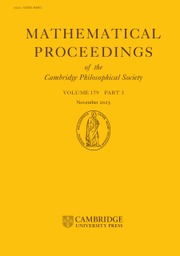No CrossRef data available.
Article contents
Local central limit theorem for triangle counts in sparse random graphs
Published online by Cambridge University Press: 14 November 2025
Abstract
Let  $X_H$ be the number of copies of a fixed graph H in G(n,p). In 2016, Gilmer and Kopparty conjectured that a local central limit theorem should hold for
$X_H$ be the number of copies of a fixed graph H in G(n,p). In 2016, Gilmer and Kopparty conjectured that a local central limit theorem should hold for  $X_H$ as long as H is connected,
$X_H$ as long as H is connected,  $p\gg n^{-1/m(H)}$ and
$p\gg n^{-1/m(H)}$ and  $n^2(1-p)\gg 1$, where m(H) denotes the m-density of H. Recently, Sah and Sawhney showed that the Gilmer–Kopparty conjecture holds for constant p. In this paper, we show that the Gilmer–Kopparty conjecture holds for triangle counts in the sparse range. More precisely, if
$n^2(1-p)\gg 1$, where m(H) denotes the m-density of H. Recently, Sah and Sawhney showed that the Gilmer–Kopparty conjecture holds for constant p. In this paper, we show that the Gilmer–Kopparty conjecture holds for triangle counts in the sparse range. More precisely, if  $p \in (4n^{-1/2}, 1/2)$, then
$p \in (4n^{-1/2}, 1/2)$, then  \[ {} {} {}\sup_{x\in \mathcal{L}}\left| \dfrac{1}{\sqrt{2\pi}}e^{-x^2/2}-\sigma\cdot \mathbb{P}(X^* = x)\right|=n^{-1/2+o(1)}p^{1/2}, {} {}\]
\[ {} {} {}\sup_{x\in \mathcal{L}}\left| \dfrac{1}{\sqrt{2\pi}}e^{-x^2/2}-\sigma\cdot \mathbb{P}(X^* = x)\right|=n^{-1/2+o(1)}p^{1/2}, {} {}\] $\sigma^2 = \mathbb{V}\text{ar}(X_{K_3})$,
$\sigma^2 = \mathbb{V}\text{ar}(X_{K_3})$,  $X^{*}=(X_{K_3}-\mathbb{E}(X_{K_3}))/\sigma$ and
$X^{*}=(X_{K_3}-\mathbb{E}(X_{K_3}))/\sigma$ and  $\mathcal{L}$ is the support of
$\mathcal{L}$ is the support of  $X^*$. By combining our result with the results of Röllin–Ross and Gilmer–Kopparty, this establishes the Gilmer–Kopparty conjecture for triangle counts for
$X^*$. By combining our result with the results of Röllin–Ross and Gilmer–Kopparty, this establishes the Gilmer–Kopparty conjecture for triangle counts for  $n^{-1}\ll p \lt c$, for any constant
$n^{-1}\ll p \lt c$, for any constant  $c\in (0,1)$. Our quantitative result is enough to prove that the triangle counts converge to an associated normal distribution also in the
$c\in (0,1)$. Our quantitative result is enough to prove that the triangle counts converge to an associated normal distribution also in the  $\ell_1$-distance. This is the first local central limit theorem for subgraph counts above the so-called
$\ell_1$-distance. This is the first local central limit theorem for subgraph counts above the so-called  $m_2$-density threshold.
$m_2$-density threshold.
MSC classification
Information
- Type
- Research Article
- Information
- Copyright
- © The Author(s), 2025. Published by Cambridge University Press on behalf of Cambridge Philosophical Society

